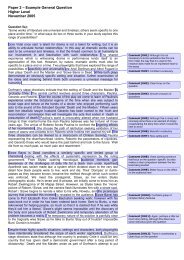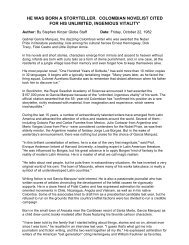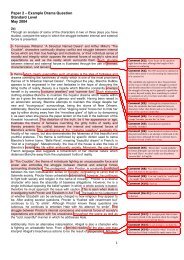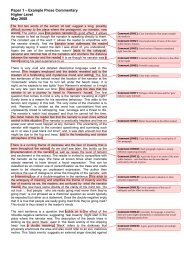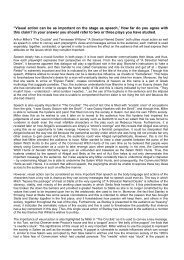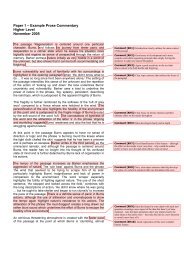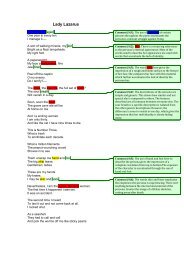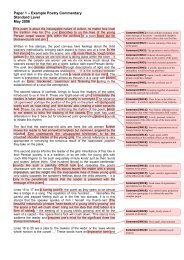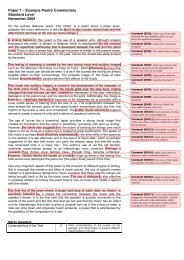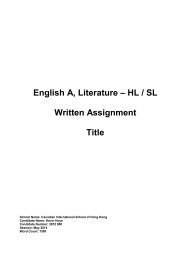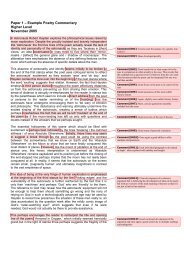Paper 1 – Example Poetry Commentary Higher Level May 2003
Paper 1 – Example Poetry Commentary Higher Level May 2003
Paper 1 – Example Poetry Commentary Higher Level May 2003
Create successful ePaper yourself
Turn your PDF publications into a flip-book with our unique Google optimized e-Paper software.
<strong>Paper</strong> 1 <strong>–</strong> <strong>Example</strong> <strong>Poetry</strong> <strong>Commentary</strong><br />
<strong>Higher</strong> <strong>Level</strong><br />
<strong>May</strong> <strong>2003</strong><br />
The poem “Night Wind”, written by Christopher Dewdny in 1984, is a<br />
mélange of diverse elements. At heart, it is a celebration of nature, of<br />
the permanence and freedom of the night wind. At the same time,<br />
the poem relates the personal journey and transformation of a man,<br />
the author, as he takes flight upon the wind, “rising on wings of<br />
darkness”.<br />
In the first stanza, the author offers a description of the wind on a<br />
particular night. The author establishes in the first three lines his<br />
narrative stance as an observer, using a first-person perspective in<br />
his writing. His usage of this particular style alerts the reader that this<br />
poem will entail a very personal dialogue in which he will directly<br />
relate his senses, experiences and impressions. Indeed, the author<br />
immediately relates his impressions of the unity of the wind in all<br />
times and places that he has ever known. Though the author treats<br />
the wind as an omnipresent force or stream, he regards it at the<br />
same time as very transient and fleeting. By stating that the wind is<br />
“endlessly departing” the author gives the sense that the wind is<br />
spread over the entire continuum of his existence but at the same<br />
time always rushing off to be at another location. The author first<br />
mentions the wind’s interactions with nature by stating that the wind<br />
blows deep into each tree. This image of trees fighting against a<br />
pervasive wind is repeated in the second staza. Finally, to end his<br />
first descriptive stanza, the author begins his personification of the<br />
wind by assigning it such qualities as “restlessness”, “impatience”<br />
and playfulness.<br />
The author continues using this device in the second stanza as he<br />
relates the impression of being implored or claimed by the wind. Both<br />
of these actions suggest to the reader that the wind is not so much a<br />
natural force as it is an actual entity with actions and desires. The<br />
author employs an allusion to the “exodus” of the Jews from Egypt<br />
as recorded in the Bible to describe the way in which the wind<br />
passes over the face of the earth calling out for others to join it. In<br />
much the same way as the Jews may have called out in joy to one<br />
another to put down their labours and to join the leaving masses, so<br />
too does the wind call out and remonstrate with the author to leave<br />
his terrestrial prison. Again using personification, the wind “wrestles”<br />
with the very trees as it passes.<br />
In the third stanza, the author undergoes a very important<br />
transformation. He releases himself to the power of the wind and is<br />
caught up in a “storm of longing” on its “wings of darkness”. Perhaps<br />
the author feels as if he is imprisoned upon the earth and longs to<br />
visit faraway places, borne on the wings of the wind. The wind is<br />
happy to receive him, taking on a “giddy rush”. As the author<br />
relinquishes control of himself he suddenly becomes aware that<br />
there is a “music in the wind”. Only after letting go of himself does<br />
the author become fully attuned to the sounds of the night. Indeed,<br />
every sound becomes as an orchestra if one considers the<br />
descriptions of the author to be true. Words such as “clamour”,<br />
“percussion”, and “thrum” are generally reserved to describe great<br />
cacophonies of noise. Yet, in the third stanza, the author employs<br />
hyperbole as he exaggerates the rustle of leaves as a “clamour”. It is<br />
unclear whether this exaggeration of sounds comes as a gift from the<br />
Comment [K1]: Clear focus on poet and text straightaway<br />
Comment [K2]: Great vocabulary<br />
Comment [K3]: Excellent range of three organising principles<br />
succinctly picked out<br />
Comment [K4]: Nice use of quotation to end the introduction<br />
rather than a list of literary features <strong>–</strong> this suggests real confidence<br />
Comment [K5]: Clear topic for this paragraph, the essay is also<br />
organized sensibly along chronological lines <strong>–</strong> this is especially<br />
fitting given the progressive nature of the poem<br />
Comment [K6]: Good literary terms smoothly used<br />
Comment [K7]: Clear explanation of the effect on the reader.<br />
Introduced by the original phrase ‘alerts the reader’<br />
Comment [K8]: Nice, original connective, indicating that the<br />
idea will be developed further<br />
Comment [K9]: Good main point <strong>–</strong> although there is no<br />
evidence to support it<br />
Comment [K10]: Again, clear effect on the reader discussed.<br />
The candidate has picked up on a subtle point here<br />
Comment [K11]: This point seems out of place here and doesn’t<br />
seem to fit in with what’s going on in the rest of the paragraph<br />
Comment [K12]: These points are well picked out but the<br />
candidate does not go on to explain why the poet has done this. The<br />
candidate does go on to consider this in the next paragraph but it<br />
seems odd not having a comment here<br />
Comment [K13]: Clear linking phrase makes obvious the<br />
progression from one paragraph to another<br />
Comment [K14]: An excellently well developed and well<br />
explained point with some great vocabulary <strong>–</strong> compare this to the<br />
treatment of the same point in <strong>Example</strong> 2!<br />
Comment [K15]: Clear linking sentence which indicates a<br />
change from the subject of the previous paragraph<br />
Comment [K16]: Clear main point<br />
Comment [K17]: Smooth use of quotations<br />
Comment [K18]: Good identification of key words, although it<br />
is done a little heavy-handedly here given the smooth style of the<br />
rest of the essay<br />
Comment [K19]: This connective suggests a contrast, although<br />
it is more the case that the hyperbole adds to the point this<br />
candidate is making
wind as the author is integrated into a storm or merely because he<br />
has taken the time to stop to listen.<br />
The fourth stanza relates the incredible experiences of the author as<br />
he rides upon the wind. The last stanza found the author in a bizarre<br />
new plane of existence, but this stanza finds him “racing” along<br />
familiar locales such as fields or playgrounds. In an instance of<br />
metaphor, the author compares himself to the “bloodrun of the<br />
atmosphere”. I personally find this comparison very apt as it relates<br />
wind passing over the surface of the earth to blood coursing through<br />
veins in the body. It is interesting to note that when he is embodied<br />
on the wind, the author notices details as insignificant as litter<br />
(newspapers) in the street along with details as macroscopic as the<br />
Milky Way above. As well, the author relates the experience of<br />
“racing down deserted streets”, again creating the impression that<br />
wind inhabits all places and times of the earth, even when no others<br />
are about to experience it.<br />
The fifth and final stanza lists more locales through which the author<br />
floats along the wind: forests, highways, oceans, and rivers. Yet,<br />
perhaps the most important development in this stanza comes from<br />
the first line “I pace the wind”. Throughout the poem, the author’s<br />
celebration of nature a recurring theme. With this line, we begin to<br />
understand a bit of the personal relationship and camaraderie that<br />
exists between the night wind and the author. To “pace” someone is<br />
to run along or to compete with that person. The author has become<br />
very intimate with the wind and nature, and as result of that<br />
relationship he is offered an incredible journey. However, the poem<br />
begs the question: Was the journey physical or mental for the<br />
author? The obvious response to this enigma is that the author has<br />
taken time to stop and listen to the music of the wind and has<br />
allowed his mind to comprehend its enormity. While not even<br />
remotely didactic in nature, this poem compels me to listen now to<br />
the wind and appreciate its energy and life.<br />
The final stanza concludes by mentioning that the wind has but one<br />
command: “a joyous delirium with nothing at its end”. Such a<br />
command reflects the gaiety, the lightness, and the energy of the<br />
wind. The wind has no clear direction and no purpose, but at the<br />
same time it is immortal. The wind is expressed as a continual “joie<br />
de vivre”.<br />
Looking back at the poem as a whole, one must consider the setting.<br />
The poem takes place at night across many locations. The<br />
importance of the many locales in relation to the omnipresence of the<br />
wind has been previously discoursed upon here, but why did the<br />
author choose to set the poem at night? Did the poem have to be set<br />
at night to be effective? The clear answer to this question is: yes. By<br />
setting the poem at night, the author borrows from a universal<br />
archetype: darkness. The night is by definition absent of light and<br />
warmth. It is dark and mysterious. Yet at the same time, the night<br />
affords the author to remain hidden alone out of sight as he rides the<br />
wind. The night is more wild and full of freedom than the day,<br />
qualities essential for the liberating and delirious journey undertaken<br />
by the author. As well, wind is invisible to the human eye. At night<br />
time, when light is scarce, the wind becomes just as alive to the<br />
other sense organs as anything else. The primary sense organ is<br />
useless at night, making night the perfect setting to appreciate the<br />
“music of the wind” using auditory sense. Because of the setting,<br />
Comment [K20]: While it is nice that two possible<br />
interpretations are identified, the implications of each, or at least the<br />
candidates preferred reading could have been examined more<br />
Comment [K21]: Interestingly the candidate has reversed the<br />
normal Linking Phrase <strong>–</strong> Main Point order and has the main point<br />
or topic sentence first followed by the linking phrase which makes<br />
it clear how this paragraph follows on from the previous one. Nice<br />
variety in paragraph structure!<br />
Comment [K22]: A good point, but why has the author chosen<br />
to do this? Despite some excellent analysis, this candidate<br />
occasionally fails to really fully develop ideas in depth<br />
Comment [K23]: This is not a very good connective<br />
Comment [K24]: Clear analysis of the effect on the reader<br />
Comment [K25]: Clear topic sentence, although the stanza by<br />
stanza approach is getting a little boring<br />
Comment [K26]: I like this candidate’s ability to personally<br />
evaluate the most important / effective elements of the poem<br />
Comment [K27]: Clear reference back to organising principles<br />
Comment [K28]: This is a nice subtle point<br />
Comment [K29]: Questions raised by the poem are well<br />
considered, although they may fit better in a conclusion<br />
Comment [K30]: Clear and often interesting explanations are<br />
attached to every point<br />
Comment [K31]: This signals a change in the structure of the<br />
essay which will now be looked at holistically. However, the phrase<br />
‘Looking back …’ is a little too informal<br />
Comment [K32]: It is never a good idea to point out your own<br />
repetitions, especially in such a pompous manner!<br />
Comment [K33]: This interrogative style is also inappropriate<br />
to essay writing<br />
Comment [K34]: An interesting point <strong>–</strong> although the candidate<br />
seems to be a little lost here<br />
Comment [K35]: The candidate does, however, manage to<br />
make a valid point
“Night Wind” is an effective title to this poem, a celebration of<br />
freedom and adventure in the night skies.<br />
Structurally, the poem consists of five stanzas each harbouring<br />
between six and ten lines. No clear rhyme scheme is followed.<br />
Indeed the only instance of end rhyme occurs in lines seven and<br />
eight. The fact that the author does not rely upon rhyme to produce<br />
sonorous effects places more emphasis on the sound words such as<br />
“clamour”, “bang” and “muffled” in the third stanza. There are several<br />
notable instances of alliteration in the poem including: “strains like<br />
something” in line and “down deserted streets” in line thirty-two. The<br />
instances are notable because they are the only two examples to be<br />
found. The dearth of traditional poetic devices such as alliteration<br />
and rhyme, coupled with the author’s unorthodox capitalization<br />
scheme in which he does not capitalize the first word in each line,<br />
gives the author a very distinct style. His style might be compared to<br />
the wind in the in the poem following no clear path or rules and<br />
following an absurd, delirious course.<br />
In fact, the author’s style epitomizes the poem. “Night Wind” tells the<br />
story of a man’ upon the wind. It tells the story of an escape into<br />
new-found freedom. At the same time, the poem is a celebration of<br />
nature and a description of the wind. The author’s intent is clearly to<br />
relate a very meaningful experience and to inspire others to share in<br />
a similar undertaking. Above all else, this poem shows a new-found<br />
respect for a very common subject.<br />
Key:<br />
Topic sentences <strong>–</strong> to indicate subject of a paragraph<br />
Organising Principles or points relating to them<br />
Connective words used to join ideas together<br />
Quotations<br />
Analysis <strong>–</strong> considering the effect on the audience<br />
Storytelling<br />
Spelling / Grammatical mistakes<br />
Examiner’s Comments:<br />
Good, sound use of literary terms and some great vocabulary. Although the<br />
candidate is obviously showing off with ‘melange’ it works well, despite the<br />
occasional pomposity.<br />
Some excellently detailed points which suggest a clear understanding of the<br />
poem. Many points are analysed well, although there are a number of occasions<br />
where some interesting ideas could have been examined in more depth<br />
Clear organising principles in the introduction, all of which are related to deeper<br />
themes or ideas. Note that the ‘story’ of the poem is just alluded to in passing.<br />
Generally clear stanza by stanza structure, although this breaks down a little<br />
towards the end<br />
Marks Awarded:<br />
Understanding of the Text 5 Clear understanding of the basic story<br />
and an obviously personal grasp of<br />
the freedom and beauty of the journey<br />
on the Night Wind that the poet is<br />
trying to relate<br />
Interpretation of the Extract 4 Excellent <strong>–</strong> this is clearly personal and<br />
original work. References are always<br />
relevant however they are not always<br />
analysed in detail: what effect, for<br />
example does the personification of<br />
the wind described in paragraph two<br />
have?<br />
Comment [K36]: The candidate is once again a little lost, the<br />
discussion of the loss of our ‘primary sense organ’ is a little by the<br />
by and could have been done more concisely<br />
Comment [K37]: Clear topic sentence, although the essay has<br />
lost a little of its structure now and the candidate is making random<br />
points <strong>–</strong> probably because they still had time left and wanted to fill<br />
it<br />
Comment [K38]: This may be true, but why emphasise those<br />
words<br />
Comment [K39]: This is a nice complex point<br />
Comment [K40]: Return to original organising principles and a<br />
summary of the story to indicate that a conclusion is being reached<br />
Comment [K41]: Clear and definite final point
Appreciation of Literary<br />
Features<br />
4<br />
Literary features are well identified<br />
although, as above, the effect of these<br />
is not always analysed<br />
Presentation 5 Well structured, working through the<br />
poem stanza by stanza and drawing<br />
the whole poem together in the<br />
conclusion ending with a good<br />
summary of the overall message of<br />
the poem<br />
Language 5 Excellent language <strong>–</strong> clear, precise,<br />
adventurous and controlled <strong>–</strong> phrases<br />
like ‘joie de vivre’ and words like<br />
cacophony and mélange just make it<br />
23 <strong>Level</strong> 7



